Light fixtures
Most professional cleaners start from the top and work their way down. That way, all the dust and debris fall to the ground, explains Sarah Karakaian, a home rental consultant who uses her cleaning and house-staging expertise to help clients improve their rental properties. “The last thing you want to do is spend an hour mopping your floor only to have dust from the top of your light fixture or cabinet dot the floor,” she says.
How you clean a light fixture will depend on what type it is. Chandeliers can be dusted and/or sprayed with a drip-dry crystal cleaning solution, while pendant light fixtures can be wiped down with a splash of vinegar and a microfiber cloth. Safety note: Before cleaning any light fixture, make sure it’s turned off and the bulb is cool. If you need help reaching it, use a step ladder, not your kitchen chair or another piece of furniture.
Cabinets
After you’ve cleaned the light fixtures, start on any crown molding on your cabinets. Wipe the dust off the top with a microfiber cloth and work your way down the cabinet door. To clean away grease, fingerprints, or any other spots or stains, try washing the doors with a few drops of Dawn in water and a microfiber cloth. “Avoid abrasive cleaning products that could damage your cabinet finish,” Karakaian says.
If that doesn’t work, create a paste of water and Tide Powder, apply it to the spot and let it sit for a few minutes, before lightly rinsing and then wiping away with a microfiber cloth, she recommends.
Pay special attention to cabinets near the stove, oven, and microwave, as they may have food splashes on them. Another area on cabinets that’s often forgotten is the wood detailing, Karakaian says. “These tight spots can get very dusty.” A clean, soft toothbrush and the dish soap mixture can help you get the nooks and crannies clean.
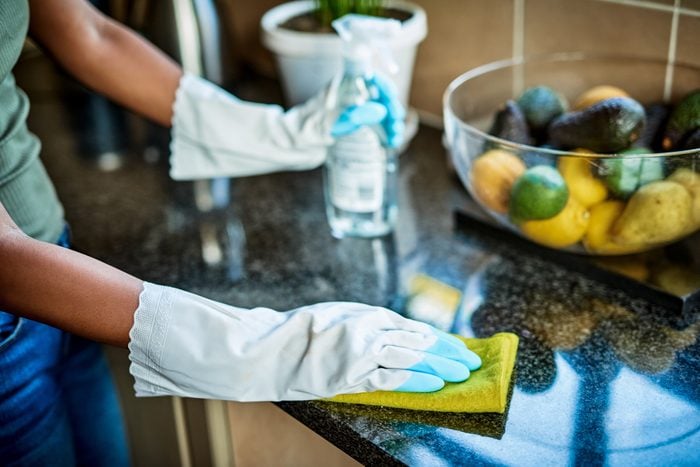
CHARDAY PENN/GETTY IMAGES
Countertops
To clean countertops made of natural stone, such as quartz or granite, use simple dish soap—Karakaian prefers Dawn—and water to gently rinse away any particles with a microfiber rag; never use a harsh, abrasive sponge. The same process works for laminate counters.
For caked-on gunk, carefully use a razor to loosen the substance, then clean as normal. Rings from a wine glass or a coffee stain can be erased by letting a dash of Bar Keeper’s Friend sit on the surface for a few minutes before wiping it away with a cloth and warm water. For an even faster fix, the Magic Eraser will buff that red wine stain out in a jiffy.
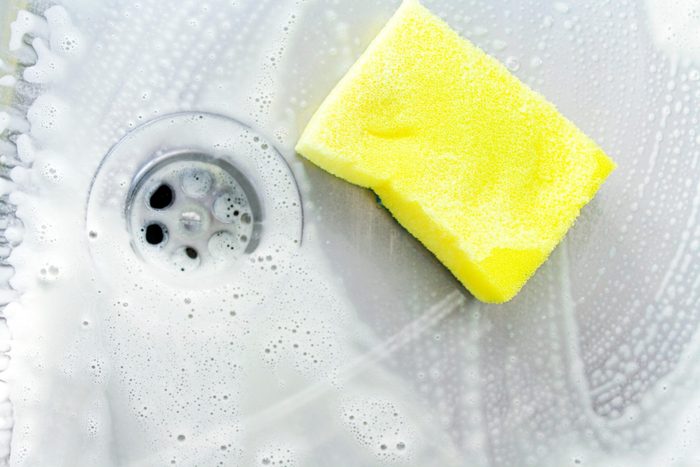
DEEPBLUE4YOU/GETTY IMAGES
Sink
To clean chrome, stainless steel, or metal finishes on the sink, Karakaian likes to use Bar Keeper’s Friend powder, letting it sit for a few minutes before wiping it away with a cloth. You’d be surprised at how much grime builds up right by the drain, so spend a bit more attention on that area. For a natural alternative, sprinkle a bit of baking soda, let sit for a minute or two, then scrub. While you’re at it, also remember to clean and deodorize your garbage disposal.
Dishwasher
Deep cleaning a dishwasher takes a bit of time and elbow grease, but luckily, it doesn’t have to be done too frequently—about once every month should do it, depending on the model and the type of water you have. The exterior, however, is a completely different story. Grimy fingerprints, food splashes, and hard-water stains stick like crazy to stainless steel. Clorox scientist and cleaning expert Mary Gagliardi suggests wiping down the exterior with a Clorox Wipe, paying special attention to the areas around the seal, which tend to harbor bacteria, and the hinges, which can be hard to reach.
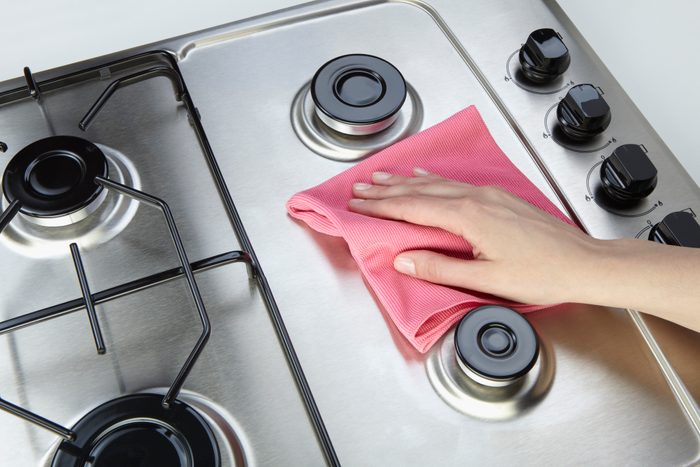
XEFSTOCK/GETTY IMAGES
Stove top
Cleaning your stove top is vital—not only because a dirty stove top looks bad, but also because food splatters contain bacteria and can lead to grease buildup, says Johnny Pallares, owner of De La Rosa House Cleaning. Bacteria, particularly from raw chicken, meat, or seafood, can lead to food poisoning, while grease can lead to a grease fire. That’s why you need to clean and disinfect your stove top.
How you clean your stove top depends on which type of stove top you have. In general, warm water with a few drops of dish soap and a microfiber towel are enough to tackle the job. For hardened food stains on a glass electric cooktop, use a small razor blade to gently chip away the spot, Karakaian says.
Fridge
Plan on cleaning the exterior of your fridge weekly to wipe down smudges and fingerprints, especially on and around the handles. Water and dish soap wiped on and off with a microfiber towel works for stainless steel. If it’s very dirty, use Bar Keeper’s Friend.
As for the inside, aim to clean your refrigerator once a month by removing all the food and tossing anything that’s old or expired, then wiping down the shelves and drawers.
Floors
The first step to cleaning your kitchen floor is to sweep or vacuum thoroughly. Next, “use the thin-nose nozzle attachment and vacuum all the crevices and corners, and up to the baseboards,” Karakaian says. Be sure to hit right under the oven and refrigerator, as well as other spots where crumbs frequently land.
If the floor is tiled and you’re going to clean your grout, whip up a thick paste of baking soda and water, or Dawn and water, and attach a microfiber cloth to a mopping tool, like a Swiffer or Bona. Glide the mop across the floor, left to right and top to bottom, catching all the dust and other particles. Vacuum up whatever doesn’t stick to the cloth.
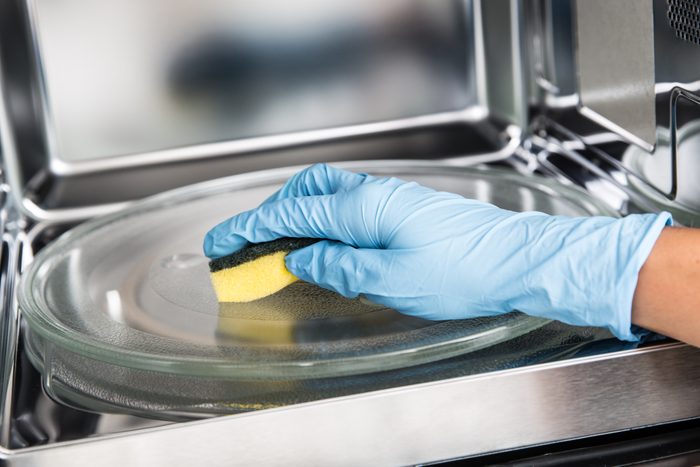
MARIANVEJCIK/GETTY IMAGES
Microwave
The more often you use it, the more you’ll need to clean your microwave. If it’s only mildly dirty, try simple soap and water on the inside and out. If there are grease or food splatters on the inside, fill a microwave-safe bowl filled with equal parts vinegar and water, place it in the microwave, and heat for one minute, says Karakaian. Let it sit undisturbed for another minute before carefully removing—it could be hot. This process loosens all the gunk stuck to the sides and top of the microwave, so wiping it clean should be easier. Don’t forget to remove the turntable and wash it with soap and water.
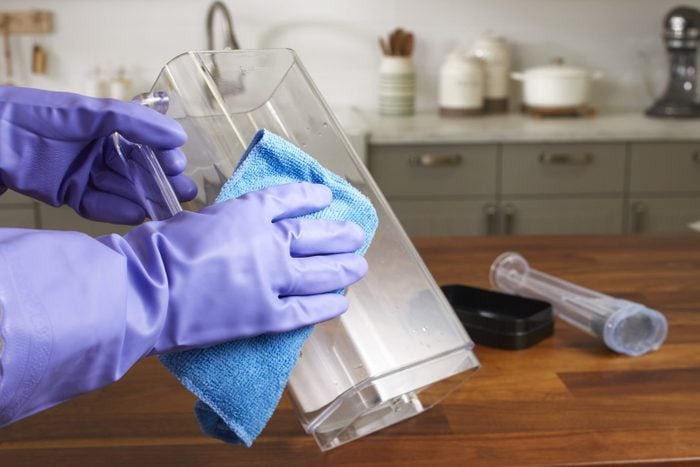
TMB STUDIO
Coffee maker
Though the exact steps you’ll take to clean your coffee maker are a bit different if you have a Keurig machine, the general idea is the same. Have white vinegar on hand—it’s food-safe and good for cleaning both the interior and exterior of your coffee maker (though you’ll want to check your specific model’s user manual first). In most cases, you can use a vinegar solution to clean the inside of your appliance and also descale it. To clean the exterior of a stainless steel or plastic coffee maker, make a mixture of one part vinegar to one part water, spray it down, and then wipe away any coffee stains or fingerprints. If your carafe is dishwasher-safe, go ahead and run it through a cycle.

Recent Comments